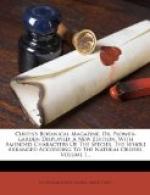[Illustration: No 137]
Is according to LINNAEUS a native of Majorca; MILLER says that it grows naturally in the Island of Minorca, from whence the seeds were sent to England by Mr. SALVADOR, an Apothecary at Barcelona, in the year 1718.
The stalks of this species are usually of a bright red colour, and covered with little warts; the leaves are small with many depressions on their upper sides like scars; the flowers are not always solitary, but frequently form a kind of Corymbus.
It is a hardy green-house plant, and readily propagated by cuttings.
It flowers during most of the Summer.
CLUSIUS informs us in his Hist. pl. rar. p. 68. that he received from THOMAS PENNY, a Physician of London, in the year 1580, a figure of this elegant plant, and who the next year shewed a dried specimen of the same in London, which had been gathered in the Island of Majorca, and named by him [Greek: murto kison], or Myrtle-Cistus[2] it appears therefore that this plant has long been known, if not cultivated in this country.
We may remark that CLUSIUS’s figure of this
plant is not
equally expressive with many of his others.
[138]
KALMIA HIRSUTA. HAIRY KALMIA.
Class and Order.
DECANDRIA MONOGYNIA.
Generic Character.
Calyx 5-partitus. Corolla hypocrateriformis:
limbo subtus
quinquecorni Caps.
5-locularis.
Specific Character.
KALMIA hirsuta foliis ovato-lanceolatis hirsutis
sparsis, floribus
racemosis.
[Illustration: No 138]
This new species of Kalmia which we have called hirsuta, the stalk, leaves, and calyx, being covered with strong hairs, was imported from Carolina in the Spring of 1790, by Mr. WATSON, Nurseryman at Islington, with whom several plants of it flowered this present Autumn, about the middle of September, from one of which our drawing was made.
The plants were brought over with their roots enclosed in balls of the earth in which they naturally grew, which on being examined appeared of a blackish colour, and full of glittering particles of sand; similar indeed to the bog-earth which we find on our moors and heaths; there is therefore little doubt (for no account accompanied the plants) but this Kalmia grows on moorish heaths, or in swamps.
In its general appearance it bears some resemblance to the Andromeda Daboecii; from the specimens we have seen its usual height would appear to be from two to three feet; it grows upright; the flowers which are about the size of those of the Kalmia glauca, are of a purple colour, and contrary to all the other known Kalmia’s grow in racemi.
It is propagated by layers, and requires the same treatment as the rest of the genus, that is, to be planted in bog-earth, on a north border: as this however is a new, and of course a dear plant, it will be most prudent till we know what degree of cold it will bear, to keep it in a pot of the same earth, plunged in the same situation, which may be removed in the Winter to a green-house or hot-bed frame.




